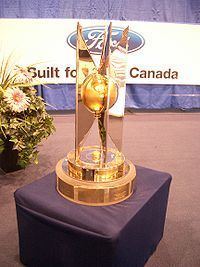Sport Curling Number of teams 12 | No. of teams 12 | |
 | ||
Founded 1959 (men)1979 (women) Most recentchampion(s) Canada (men) Canada (women) Most titles Canada (men; 35 titles) Canada (women; 16 titles) Instances 2016 Ford World Women's, 2015 Ford World Men's Cu, 2015 World Women's Curling C, 2010 Ford World Women's, 2010 Capital One Worl | ||
The World Curling Championships are the annual world championships for curling, organized by the World Curling Federation and contested by national championship teams. There are men's, women's and mixed doubles championships, as well as junior and senior championships for each gender. There is also a world championship for wheelchair curling. The men's championship started in 1959, while the women's started in 1979. The mixed doubles championship was started in 2008. Since 2005, the men's and women's championships have been held in different venues, with Canada hosting one of the two championships every year: the men's championship in odd years, and the women's championship in even years. Canada has dominated both the men's and women's championships since their inception, although Switzerland, Sweden, Denmark, Germany (West Germany), Scotland, the United States and Norway have all won at least one championship.
Contents
History
The World Curling Championships began in 1959 as the Scotch Cup. The first three Cups were contested between men's teams from Scotland and Canada. The United States joined the Scotch Cup in 1961, and Sweden also joined the next year. Canada won the first six world titles, of which the legendary rink skipped by Ernie Richardson earned four. The United States was the first country to break Canada's streak, winning their first world title in 1965. By 1967, Norway, Switzerland, France, and Germany were added to the Scotch Cup, and Scotland won their first title, while Canada finished without a medal for the first time. The tournament was renamed the Air Canada Silver Broom the year after that, and Canada strung together five consecutive world titles starting in that year.
In 1973, the competing field was expanded to ten teams, and Italy and Denmark were introduced to the world stage. Sweden, Switzerland, and Norway won their first titles in the following years, and Canada continued to win medals of all colours. In 1979, the first edition of the women's World Curling Championships was held. The championships were held separately from the men's championships for the first ten years. During this time, Switzerland, Canada, Sweden, Denmark, and Germany won world titles.
Beginning in 1989, the men's and women's championships were held together. Norway won their first world women's title. In 1995, Ford Canada and the World Curling Federation reached an agreement to make Ford the sponsor of the World Curling Championships. Japan, the first nation from Asia to compete in the worlds, made their debut in 1990 at the women's championship, and later in 2000 at the men's championship. South Korea and China followed suit in the 2000s. Scotland won their first women's title in 2002, and the United States won their first women's title the next year.
In 2005, the men's and women's championships were separated, and an agreement was made between the World Curling Federation and the Canadian Curling Association that one of the two world championships would be sponsored by Ford Canada and would be held in Canada each year. Canada began a streak of top two finishes in the men's tournament, and China won their first world title in the women's tournament in 2009.
In 2008, a world championship for mixed doubles curling was created. Switzerland won the first world mixed doubles title, and proceeded to win four of the first five titles. Russia and Hungary won their first world curling titles in the mixed doubles championship, and New Zealand, France, Austria, and the Czech Republic won their first world curling medals.
In 2015, a world championship for mixed curling was created, replacing the European Mixed Curling Championship and supplanting the European Mixed and Canadian Mixed curling championships as the highest level of mixed curling in the world.
Bronze medals were not awarded until 1985 for the women's tournament and 1986 for the men's tournament. Between 1989 and 1994, the bronze medal was shared by the semifinals losers.
Tournament names
The World Curling Championships have been known by a number of different names over the years.
Men
Women
Competition format
The first two world championships, held as competitions between Scotland and Canada, were held as five-game series between the two nations. Upon the addition of the United States in 1961, the format was changed to a double round robin preliminary round with a three-team knockout round at the conclusion of the round robin. The knockout round was removed for the next two championships. With the addition of more teams, a single round robin preliminary round with a four-team knockout round was implemented in 1971. The championships occurring from 1968 to 1970 included three-team knockout rounds instead of four-team knockout rounds. The knockout round format was adjusted from single-elimination to the Page playoff system in 2005.
In the championships held from 1971 to 1985, third place was awarded to either the team that lost in the semifinal of a three-team knockout round or the higher-seeded team among the losing teams of a four-team knockout round. A bronze medal game was added to the knockout round in 1986, but bronze medal games were not held from 1989 to 1994, during which bronze medals were awarded to the teams that lost in the semifinals.
The current format of the world championships uses a twelve team round-robin preliminary round, after which the top four teams advance to a knockout round held using the Page playoff system.
